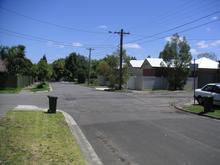In general, there are two types of intersections including signalized and unsignalized intersections.[1] An uncontrolled intersection is a road intersection where no traffic lights, road markings or signs are used to indicate the right-of-way. They are found in either residential neighborhoods or in rural areas. While the intersection itself is unmarked, warning signs or lights may be present to alert drivers to it.
Uncontrolled T-intersection
At an uncontrolled T-intersection (3-way intersection), right-of-way rules differ from country to country. In Australia, the United Kingdom, New Zealand[2] and most of the United States, traffic on the terminating road must give way (yield) to traffic on the continuing road. In Germany,[3] traffic generally has to give way to traffic on the right at an uncontrolled intersection, whether it is a 3-way intersection or not.
Uncontrolled 4-way intersection
At uncontrolled 4-way intersections the common rules are
- give way to traffic approaching from the passenger's side (i.e. from the right in countries that drive on the right-hand side, rule known as priority to the right, and vice versa)
- however, this may be the opposite depending on the local laws
- turning traffic with crossing paths usually gives way to traffic driving straight through in the opposite direction
- drivers opposite one another and both turning in their same direction, e.g. both drivers turning to their right (in countries that drive on the right-hand side), do not need to give way to one another as their paths will not cross.
Common practice dictates that drivers will treat the intersection as if they have a give way (yield) sign and look both directions for cross-traffic to avoid any accidents with motorists who did not recognize or did not follow the uncontrolled intersection rule.
References
- ^ Ali Sahraei, Mohammad; Akbari, Elnaz (2020-03-19). "Review and evaluation of methods for estimating delay at priority junctions". Australian Journal of Civil Engineering: 1–14. doi:10.1080/14488353.2020.1743591. ISSN 1448-8353.
- ^ "New Zealand give way rules". 2014-07-27. Retrieved 19 March 2018.
- ^ [1] http://www.gesetze-im-internet.de/stvo/__8.html - in German - Federal Ministry of Justice (Germany) - de:Straßenverkehrs-Ordnung (Deutschland): Vorfahrt - (German) Road Traffic Order: Right-of-way - Section 8 - Retrieved on September 20, 2012
